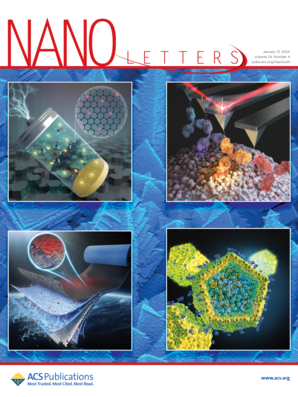Time-Resolved In Situ Small-Angle X-ray Scattering to Determine the Kinetics of Formation of Liquid Crystalline Structure in the Core of Polymeric Nanoparticles during and after Turbulent Mixing
IF 9.6
1区 材料科学
Q1 CHEMISTRY, MULTIDISCIPLINARY
引用次数: 0
Abstract
The encapsulation of liquid crystalline phases, formed from biocompatible amphiphiles, into nanoparticles has emerged as a promising delivery strategy for hydrophilic and hydrophobic therapeutics. Strategies to characterize these delivery systems as a function of formulation parameters and aqueous environment post-manufacture are well-documented. A critical gap remains regarding the assembly kinetics and in situ dynamics of these systems using industrially relevant manufacturing techniques. Systematically investigating these characteristics is challenging: computational simulations are time-intensive and costly, while current in situ quantification techniques are limited in scalability and batch size. We here combine synchrotron small-angle X-ray scattering with Flash NanoPrecipitation, a scalable turbulent mixing technology, to capture time-resolved measurements of the formation of liquid crystal phases under nanoconfinement during and after nanoprecipitation. This technique reveals that self-assembly occurs in two steps, with internal liquid crystal self-assembly occurring on longer time scales (seconds to minutes) than initial nanoprecipitation (milliseconds) as a function of formulation parameters.

时间分辨原位小角x射线散射测定湍流混合期间和之后聚合物纳米颗粒核心液晶结构形成动力学
将由生物相容性两亲体形成的液晶相包封成纳米颗粒已成为一种很有前途的亲水和疏水治疗递送策略。将这些输送系统描述为配方参数和制造后水环境的函数的策略是有据可证的。一个关键的差距仍然是关于这些系统的装配动力学和原位动力学使用工业相关的制造技术。系统地研究这些特征具有挑战性:计算模拟耗时且成本高昂,而当前的原位定量技术在可扩展性和批量大小方面受到限制。我们将同步加速器小角度x射线散射与Flash纳米沉淀(一种可扩展的湍流混合技术)结合起来,在纳米沉淀期间和之后的纳米约束下捕获液晶相形成的时间分辨测量。该技术揭示了自组装发生在两个步骤中,作为配方参数的函数,内部液晶自组装发生在比初始纳米沉淀(毫秒)更长的时间尺度上(秒到分钟)。
本文章由计算机程序翻译,如有差异,请以英文原文为准。
求助全文
约1分钟内获得全文
求助全文
来源期刊

Nano Letters
工程技术-材料科学:综合
CiteScore
16.80
自引率
2.80%
发文量
1182
审稿时长
1.4 months
期刊介绍:
Nano Letters serves as a dynamic platform for promptly disseminating original results in fundamental, applied, and emerging research across all facets of nanoscience and nanotechnology. A pivotal criterion for inclusion within Nano Letters is the convergence of at least two different areas or disciplines, ensuring a rich interdisciplinary scope. The journal is dedicated to fostering exploration in diverse areas, including:
- Experimental and theoretical findings on physical, chemical, and biological phenomena at the nanoscale
- Synthesis, characterization, and processing of organic, inorganic, polymer, and hybrid nanomaterials through physical, chemical, and biological methodologies
- Modeling and simulation of synthetic, assembly, and interaction processes
- Realization of integrated nanostructures and nano-engineered devices exhibiting advanced performance
- Applications of nanoscale materials in living and environmental systems
Nano Letters is committed to advancing and showcasing groundbreaking research that intersects various domains, fostering innovation and collaboration in the ever-evolving field of nanoscience and nanotechnology.
 求助内容:
求助内容: 应助结果提醒方式:
应助结果提醒方式:


